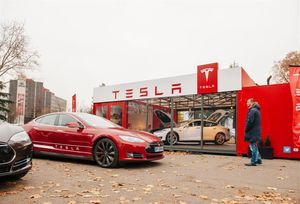
Tesla (NASDAQ: TSLA) faced a challenging second quarter in 2025, reporting a significant 12% year-over-year decline in overall revenues to $22.5 billion, primarily due to substantial headwinds in its core automotive business. The electric vehicle giant's traditional cash cow saw a notable drop in revenue, net income, operating income, and diluted EPS, signaling a period of significant pressure. However, amidst this downturn, Tesla's often-underestimated Energy Generation and Storage division emerged as a powerful counter-narrative, delivering robust performance, increased profitability, and impressive growth in deployments, thereby providing a crucial offset to the automotive slump and highlighting a pivotal shift in the company's financial dynamics.
Automotive Headwinds and Energy Tailwinds: A Tale of Two Teslas in Q2 2025
Tesla's Q2 2025 financial results painted a stark picture of a company at a critical juncture. The once-unassailable automotive segment, which historically propelled Tesla's rapid ascent, experienced considerable pressure. Total automotive revenues plummeted by a significant 16% year-over-year, settling at $16.6 billion, down from $19.8 billion in Q2 2024. This decline was attributed to a confluence of factors, including a decrease in vehicle deliveries, intensified competition leading to lower average selling prices, and reduced revenue from regulatory credits. The repercussions were deeply felt across the segment's profitability metrics: GAAP net income dropped 16% year-over-year to $1.17 billion, while operating income saw an even steeper contraction of 42% year-over-year, falling to $923 million. Diluted EPS (GAAP) followed suit, decreasing by 18% year-over-year to $0.33, with non-GAAP diluted EPS also declining by 23% to $0.40. The company's overall operating margin consequently contracted to 4.1%, a notable drop from 6.3% in Q2 2024, reflecting the challenging market conditions for electric vehicles. Vehicle deliveries also experienced a dip of 13-14% year-over-year, totaling approximately 384,122 units.
In sharp contrast, Tesla's (NASDAQ: TSLA) Energy Generation and Storage business delivered a surprisingly strong performance, emerging as a critical driver of profitability and future growth. Despite a slight revenue decrease of 7.7% year-over-year to $2.78 billion from $3.01 billion in Q2 2024, the segment's underlying financial health dramatically improved. For the first time, the energy business achieved significant profitability, with margins topping over 30% in Q2 2025 and contributing a record $846 million in gross profit for the quarter. Remarkably, this division, representing only 12-13% of total revenue, accounted for 23% of Tesla's total profit in the first half of 2025. This robust growth was fueled by a substantial 48% year-over-year increase in energy storage deployments, with Tesla deploying 9.6 GWh of energy storage products—a 30% surge compared to Q2 2024. The strong demand for both grid-scale and behind-the-meter energy systems, coupled with surging renewable integration and supportive policy incentives, underscored the strategic importance of this segment. This divergence in performance between Tesla's two primary businesses not only highlights the shifting dynamics within the company but also signals a broader trend in the market where sustainable energy solutions are gaining significant financial traction.
Shifting Fortunes: Who Wins and Loses in Tesla's Evolving Landscape
Tesla's (NASDAQ: TSLA) Q2 2025 financial results have sent ripples through the automotive, battery, and renewable energy sectors, clearly delineating winners and losers in a rapidly evolving market. The significant contraction in Tesla's automotive segment, marked by declining deliveries and profitability, has created substantial opportunities for rival electric vehicle (EV) manufacturers. Simultaneously, the explosive growth and newfound profitability of Tesla's Energy Generation and Storage business are bolstering the entire renewable energy and battery storage ecosystem, benefiting a diverse array of companies.
Among the clearest beneficiaries of Tesla's automotive slowdown are its direct competitors. Traditional automakers aggressively pivoting to EVs, such as General Motors (NYSE: GM), Ford (NYSE: F), and Volkswagen (OTC: VWAGY), are increasingly capturing market share. Ford, in particular, has seen a surge in Battery Electric Vehicle (BEV) registrations, solidifying its position among the top three EV brands. Asian giants like BYD (OTC: BYDDY), a dominant global player in both EVs and energy storage, are reporting triple-digit growth, leveraging cost-effective and integrated approaches. South Korean automakers Hyundai (OTC: HYMTF) and Kia (OTC: KIMTF) are also boosting sales through attractive incentives and new EV models. Even luxury EV players like Rivian (NASDAQ: RIVN) and Lucid Group (NASDAQ: LCID) are intensifying competition in their respective niches, while Chinese manufacturers Nio (NYSE: NIO) and Xpeng (NYSE: XPEV) continue to expand their market presence.
Conversely, the booming energy segment creates a different set of winners. Battery suppliers are enjoying heightened demand, particularly those involved in Tesla's Megapack production. LG Energy Solution (KRX: 373220) stands out, having secured a significant $4.3 billion deal with Tesla for LFP batteries used in Megapacks, while also expanding its overall product lineup. Panasonic Holdings (OTC: PCRFY), a long-standing Tesla partner, and CATL (SHE: 300750), a global leader in battery cells, are also poised for continued growth. Raw material providers like Albemarle (NYSE: ALB) and Livent Corporation (NYSE: LTHM), key players in lithium production, are direct beneficiaries of the overall surge in battery demand for both EVs and energy storage. Beyond manufacturing, renewable energy and energy storage companies are thriving. Fluence Energy (NASDAQ: FLNC) is expanding its operations, securing large contracts for storage systems. Utilities like NextEra Energy (NYSE: NEE) and diversified renewable energy firms such as Brookfield Renewable Partners (NYSE: BEP) and Brookfield Renewable Corporation (NYSE: BEPC) are well-positioned to capitalize on increasing investment in clean energy infrastructure. Companies like Enphase Energy (NASDAQ: ENPH), First Solar (NASDAQ: FSLR), and Stem Inc. (NYSE: STEM), involved in solar technology, home energy solutions, and AI-driven storage, respectively, are seeing increased demand as distributed renewable generation and grid modernization accelerate.
The primary "loser" in this scenario, at least within its traditional core business, is Tesla (NASDAQ: TSLA) itself, specifically its automotive segment. The reported decline in U.S. market share and global sales, coupled with price reductions to maintain competitiveness, has directly impacted its profit margins and raised concerns about the stability of its primary revenue stream. While the success of its energy division provides a crucial offset, the struggles in automotive could weigh on its overall valuation and strategic direction, emphasizing the necessity of its diversification efforts.
Shifting Tides: Industry Impact and Broader Implications
Tesla's (NASDAQ: TSLA) Q2 2025 financial results are not merely a reflection of a single company's performance but a potent indicator of significant shifts within the broader electric vehicle (EV) and renewable energy industries. The stark contrast between an automotive slump and an energy segment boom underscores a maturing EV market, intensified competition, and the accelerating global demand for sustainable energy solutions, with far-reaching ripple effects across various sectors.
The automotive segment's decline at Tesla is emblematic of a broader deceleration in the U.S. EV market. Q2 2025 saw overall U.S. EV sales lower year-over-year by 6.3%, signaling a more mature phase of adoption. This slowdown is attributed to fluctuating consumer demand, high average transaction prices for new EVs (around $57,734), elevated interest rates, and a growing consumer preference for more affordable hybrid and plug-in hybrid electric vehicles. Tesla's once-unrivaled dominance is now heavily challenged, with its U.S. market share plummeting from 75% in 2022 to approximately 43% in 2025, and a mere 1.6% in the European EV market. This intensifying competition, particularly from aggressive Chinese manufacturers like BYD (OTC: BYDDY), Xiaomi (HKG: 1810), Nio (NYSE: NIO), and Xpeng (NYSE: XPEV) offering lower-priced alternatives, is forcing a re-evaluation of pricing strategies and product diversification across the industry. Policy shifts, including the anticipated expiration or rollback of federal EV tax credits under the Inflation Reduction Act (IRA), further complicate the market landscape, potentially dampening demand and impacting investment decisions.
In powerful opposition to the EV market's struggles, Tesla's energy segment boom aligns perfectly with robust global growth in renewable energy and energy storage. The global energy storage market is projected for record additions in 2025, with utility-scale capacity in the U.S. increasing by an impressive 63% year-over-year in the first half of 2025. This surge is driven by the imperative for grid modernization, the integration of intermittent renewable sources like solar and wind, and critically, the burgeoning energy demands of AI data centers. Companies offering solutions like Tesla's Megapack are poised to capitalize on this expanding market. However, even this booming sector faces headwinds from federal policy uncertainties, bureaucratic delays, and tariffs that have increased prices for battery energy storage systems, particularly those sourcing materials from China. Despite these challenges, the critical demand, especially from industrial applications and AI infrastructure, demonstrates a willingness to absorb higher costs, reflecting the strategic importance of energy reliability and sustainability.
The ripple effects of Tesla's Q2 performance are profound. For EV competitors, Tesla's market share loss intensifies pressure to innovate, reduce costs, and diversify their product offerings to appeal to a broader consumer base. Lower demand and aggressive pricing will likely lead to further price competition and potentially tighter margins across the EV industry, impacting pure-play EV manufacturers more severely than diversified legacy automakers. Conversely, the strong performance of Tesla's energy storage division signals a robust and growing market for competitors in battery manufacturing and grid solutions. This will likely stimulate increased investment and innovation from companies like Enphase Energy (NASDAQ: ENPH), Generac (NYSE: GNRC), and traditional energy providers entering the storage space. For suppliers, a sustained slump in automotive production could mean reduced orders, while suppliers to the energy storage sector, especially for large-scale battery components and grid infrastructure, are likely to see increased demand. Regulatory bodies worldwide face the delicate task of balancing market stimulation for EVs with the need for stable, long-term policy frameworks to support the burgeoning renewable energy and energy storage sectors, particularly given their critical role in powering the digital economy.
Historically, companies often navigate such transitions by diversifying their portfolios, a strategy exemplified by giants like Samsung (KRX: 005930) expanding into leading tech from humble beginnings, or Amazon (NASDAQ: AMZN) leveraging its e-commerce success into the cloud services dominance of AWS. Tesla's current situation mirrors these precedents, showcasing how strategic diversification can mitigate risks when a core business matures or faces new competition. The EV automotive slump can also be likened to periods of slower growth or market consolidation seen in the adoption curves of other new technologies, where initial rapid growth gives way to a "trough of disillusionment" before sustained, albeit slower, growth resumes with more affordable options and improved infrastructure. This period often sees a shakeout of less robust players and a recalibration of market expectations, highlighting the importance of adaptability and a long-term vision.
The Road Ahead: Navigating Pivots and Opportunities
Tesla's (NASDAQ: TSLA) Q2 2025 results mark a critical inflection point, setting the stage for a period of strategic re-evaluation and adaptation. The divergent performance of its automotive and energy segments necessitates immediate and long-term pivots to capitalize on burgeoning opportunities while mitigating persistent challenges in a highly dynamic global market.
In the short term, Tesla's automotive division is expected to continue grappling with intense competition and a softening global EV market. The decline in deliveries and market share across key regions like Europe, China, and the U.S. signals that pricing pressures and the proliferation of rival models will remain significant headwinds. To counteract this, Tesla is aggressively pursuing cost reduction in manufacturing and accelerating the development of its next-generation, more affordable electric vehicles. The introduction of these lower-priced models, rumored to be a "Model Q" or "Model 2" and potentially priced under $30,000, is crucial for regaining market share in the increasingly competitive entry-level EV segment. Simultaneously, the Supercharger network continues its expansion, with plans to open to more automakers throughout 2025, which, while generating revenue, also strategically positions Tesla as a foundational infrastructure provider for the broader EV ecosystem.
Longer term, Tesla's future is heavily vested in the success of its ambitious ventures in autonomy and the sustained dominance of its energy business. The rollout of Full Self-Driving (FSD) and the eventual commercial launch of Robotaxi services, including the Cybercab targeting 2026 production, represent a potential paradigm shift in urban mobility and a significant new revenue stream. While the path to Level 5 autonomy and widespread regulatory approval is fraught with technological and public trust hurdles, a successful deployment could fundamentally alter vehicle ownership models and unlock immense value. Concurrently, the energy generation and storage business is poised for exponential growth. With global energy storage installations projected to surge and the U.S. market alone expected to reach $1.49 trillion by 2034, Tesla's Megapack and Powerwall products are strategically positioned. The company's investment in dedicated Gigafactories for energy storage underscores its commitment to this sector, leveraging the insatiable demand from renewable energy integration and the voracious power requirements of AI data centers.
Strategic pivots will be paramount. Tesla must not only continue aggressive cost reductions but also refine its pricing strategies to compete effectively across diverse global markets. Further diversification beyond premium EVs is essential, with accelerated timelines for its more affordable models. Crucially, leveraging the energy segment's consistent profitability and growth to buffer automotive volatility will be a key strategy, requiring expanded manufacturing capacity and resilient supply chains. The successful monetization of FSD and Robotaxi services hinges on navigating complex regulatory landscapes and robust safety records. Additionally, enhancing customer experience and adapting to specific global market preferences will be vital to retaining loyalty and attracting new buyers amidst heightened competition. Potential scenarios range from "Energy-Driven Resilience," where the energy segment becomes the primary growth engine, to an "Autonomy Breakthrough," where Robotaxi fundamentally transforms the company and transportation as a whole. Conversely, "Intensified Competition & Diversification" could see Tesla's automotive growth remain constrained, necessitating further strategic partnerships or acquisitions. Tesla's ability to execute these complex initiatives will define its trajectory in the coming years.
Conclusion: A Pivotal Juncture for Tesla and the Broader Market
Tesla's (NASDAQ: TSLA) Q2 2025 financial results encapsulate a pivotal moment for the company, highlighting both significant challenges and immense opportunities. The key takeaway is the stark dichotomy between a struggling automotive division and a flourishing energy generation and storage business. While the year-over-year decline in automotive revenue, net income, operating income, and diluted EPS underscores the increasing saturation and competition within the EV market, the robust performance and profitability of the energy segment demonstrate Tesla's successful diversification and its crucial role in the global clean energy transition.
Moving forward, the market will likely view Tesla not just as an EV manufacturer but increasingly as a diversified technology and energy solutions provider. The lasting impact of this quarter's results is the clear validation of Tesla's long-term strategy to expand beyond cars into energy infrastructure and autonomous technology. The automotive slump, however, is a strong signal that the "EV gold rush" is evolving into a more mature, competitive, and price-sensitive market. This will necessitate greater innovation, cost efficiency, and diversification from all players in the sector. The energy segment's boom, driven by the global imperative for decarbonization and the surging power demands of AI data centers, positions Tesla as a significant beneficiary of an undeniable macroeconomic trend.
For investors, the coming months will be critical to watch for several indicators. On the automotive front, attention will be on the progress and market reception of Tesla's next-generation, more affordable vehicles, which are essential for stimulating demand and regaining market share. Any signs of improved delivery numbers or stabilized average selling prices will be crucial. In the energy sector, continued deployment growth and sustained profitability are key metrics, particularly as manufacturing capacity for Megapacks and Powerwalls scales up. Furthermore, the development and regulatory pathway for Full Self-Driving (FSD) and Robotaxi services will be a major determinant of Tesla's long-term valuation, as the successful monetization of autonomy could unlock entirely new revenue streams and fundamentally change the company's business model. Tesla's ability to navigate the fierce competition in EVs while solidifying its leadership in energy storage and advanced AI will ultimately define its enduring significance and market trajectory.





